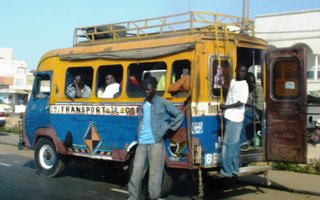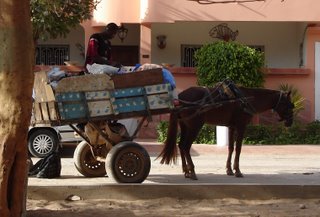 'Car Rapides' are one form of public transport here in Dakar. They are almost always beautifully painted (in a unique way), and they are plentiful. Locals call them 'Cars' for short, but the English community calls them 'Rapides' (pronounced 'ra-peedz'), probably to avoid confusion since 'car' denotes something different for us. ('Car' is used in France to describe the same vehicle we call a car, but it is not used in Francophone West Africa.) The smallest rapides seat about 25 people (packed pretty tight), but the same rapide is commonly filled with 35 to 40 people, both seated and standing (some standing on the back bumper). Pictured here is one of the small models.
'Car Rapides' are one form of public transport here in Dakar. They are almost always beautifully painted (in a unique way), and they are plentiful. Locals call them 'Cars' for short, but the English community calls them 'Rapides' (pronounced 'ra-peedz'), probably to avoid confusion since 'car' denotes something different for us. ('Car' is used in France to describe the same vehicle we call a car, but it is not used in Francophone West Africa.) The smallest rapides seat about 25 people (packed pretty tight), but the same rapide is commonly filled with 35 to 40 people, both seated and standing (some standing on the back bumper). Pictured here is one of the small models.Two men work on every rapide. The driver's duties are obvious - he drives, and that's about it. The apprentice does everything else - collect fares, 'advertise' (announce to those waiting for a ride where his particular rapide is going), pay for the gas, and clean the rapide.
Notorious for their bad driving, rapides make frequent, quick stops to drop-off and pick-up passengers, then race off from the stop hoping to get ahead of one or two other rapides to the waiting passengers at the next stop. During this race to get passengers (which is futile to begin with), the passengers on the rapides are jostled and rattled around, and the drivers seem to forget that there are other cars on the road, lending to their common participation in accidents.
The cost of riding a rapide, like any public transport system, depends on where/how far you're going. For example, I ride rapides to the University for French classes (about 1.5 miles), and I pay 125 francs (US$0.25) one-way. Compare that to a taxi, which costs 800 francs (US$1.60) one-way, and you begin to see why they are so popular.
 However, there are hidden 'costs' to riding rapides. For one, you can catch a taxi just about anywhere and have it drop you off wherever you want. Rapides, on the other hand, have certain stopping places (though you can hop-off anytime you want) which are only on the main roads. Thus for my commutes to the University, I catch the taxis a block from my home and they drop me off at the Language Institute building, but the rapides I catch two blocks from my home and they drop me off half a mile from my destination. Another hidden 'cost' is pick-pockets. I had a cell phone lifted from my pocket on a rapide, and I'm not alone - many Senegalese have their pockets picked on rapides, too. More time is also spent on rapides. My commute from home to school takes 10 minutes by taxi and 30-40 minutes by rapide.
However, there are hidden 'costs' to riding rapides. For one, you can catch a taxi just about anywhere and have it drop you off wherever you want. Rapides, on the other hand, have certain stopping places (though you can hop-off anytime you want) which are only on the main roads. Thus for my commutes to the University, I catch the taxis a block from my home and they drop me off at the Language Institute building, but the rapides I catch two blocks from my home and they drop me off half a mile from my destination. Another hidden 'cost' is pick-pockets. I had a cell phone lifted from my pocket on a rapide, and I'm not alone - many Senegalese have their pockets picked on rapides, too. More time is also spent on rapides. My commute from home to school takes 10 minutes by taxi and 30-40 minutes by rapide.Most of my colleagues rode a rapide to fill a requirement in their orientation classes, but few have ever dared to climb aboard a second time. Perhaps I'm brave, or just stupid, but I enjoy watching and talking to people on rapides - and holding onto my wallet!










